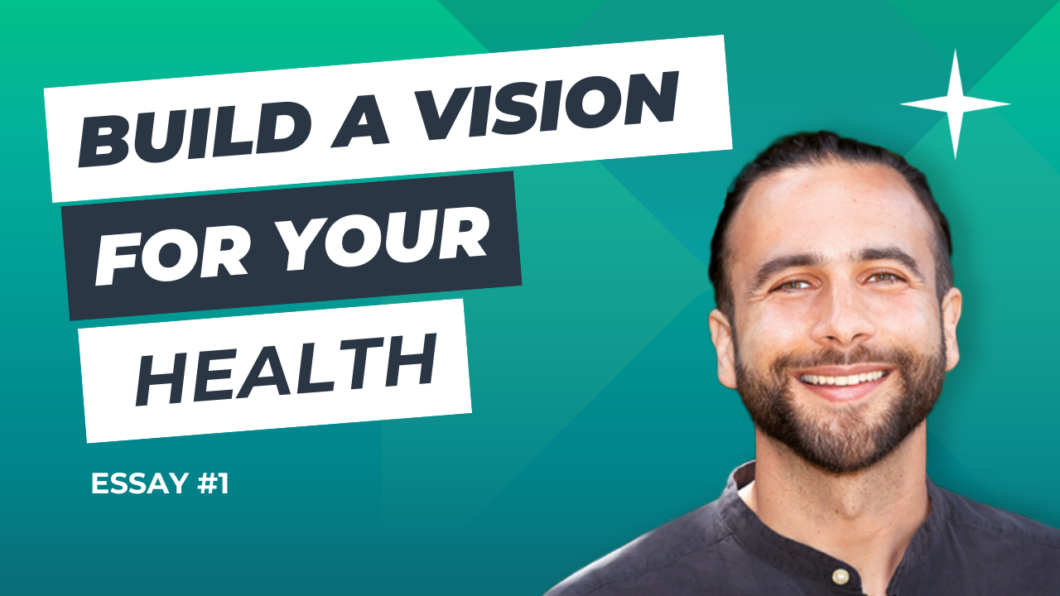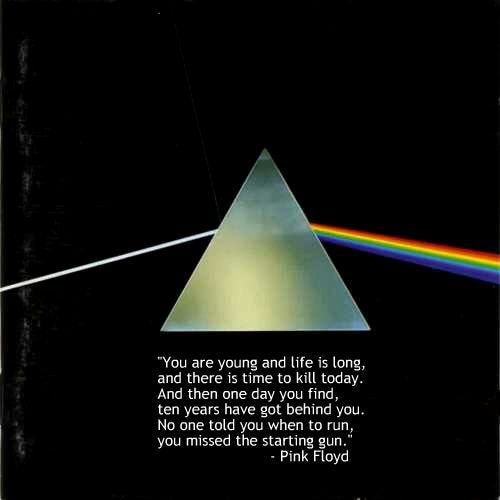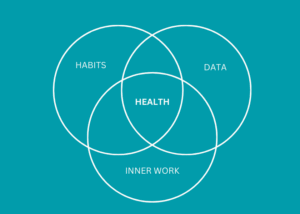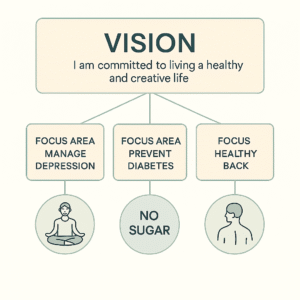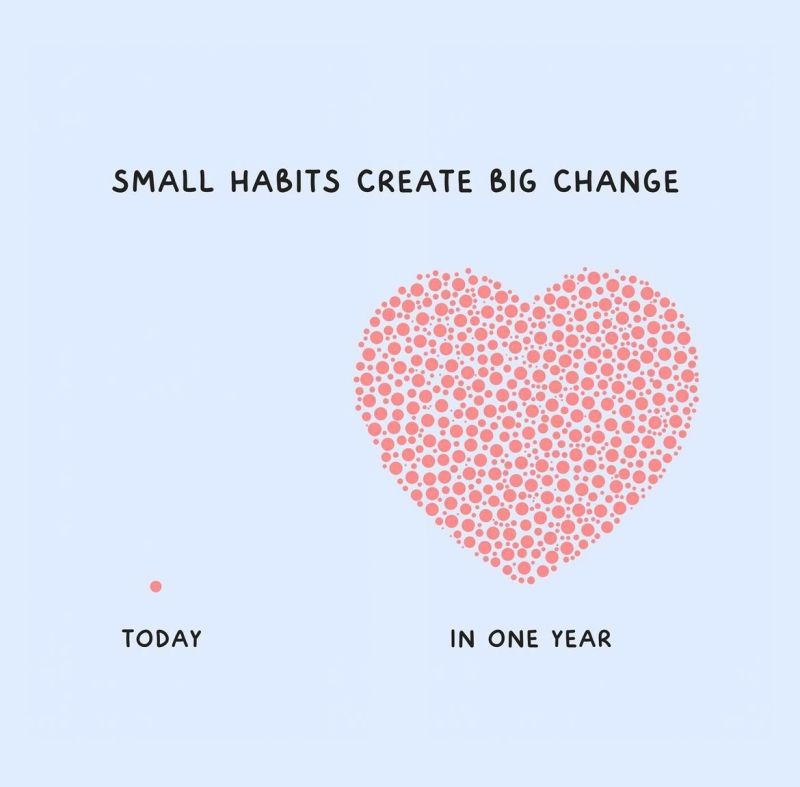How to build vision, strategy and tactics for your health. No one will do this for you!
Humanity is on the cusp of an exciting new way of being.
We dare to imagine living a chronic-disease free life in our fifties, sixties and seventies. A life that is fulfilling, both emotionally and cognitively.
It is an exciting time to improve our individual and collective health.
I have spent my entire career searching for that exciting new health frontier.
First as a doctor, then as a clinical data/digital health strategist, and now through my functional medicine practice.
While my career path has set me up to understand “the human body,” I received my true education when my body stopped working properly.
Over the years of my medical and data careers, I developed a:
- crippling depression in my last year of medical school (requiring prozac)
- terrible back pain in my late twenties (requiring analgesic injections)
- flirtation with insulin resistance (HbA1c of 5.6%) in my early thirties.
Today, I am 35 and I live a life that is free from all three (and their required medications).
There was no panacea. No silver bullet. No shortcuts. It continues to be a daily practice to keep those ‘health icebergs’ from sinking my ship.
My appetite for studying my health and my behaviors led me to address these issues in my twenties and thirties
It would’ve been easy to numb these experiences with medications until they become huge problems twenty or thirty years from now. At which point, I would go see a doctor and s/he would tell me to do the things I am doing now to battle these demons.
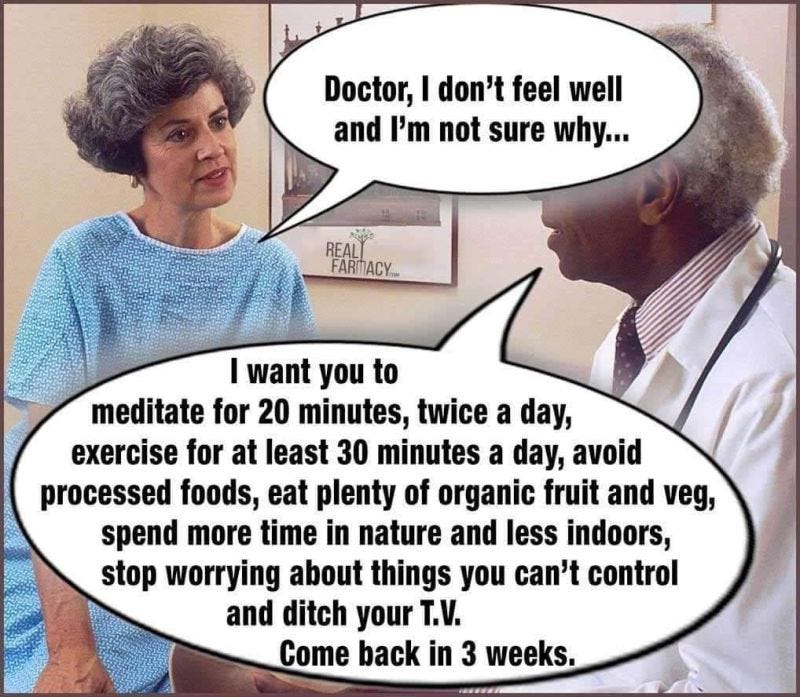
Today, I present you with a process that you can follow to identify your own health problems before they become insurmountable.
I feel confident that you too can achieve this.
That is what I want for you.
But first you must understand this: If you neglect your health in your thirties, forties and fifties, NO ONE will give it back to you.
This may become possible with more research going into longevity drugs and precision medicine, but I doubt that this will be available for you and I. Maybe our grandchildren – or their grandchildren.
What we know for sure, is that if you do not take full ownership of your health right now, no healthcare technology, institution, or amount of money will bring that back to you.
Not your hospital.
Not your insurance.
Not your lab.
Not your doctor.
These entities care about your sickness, not your health.
That is what we train them for.
That is why most doctors are leaving medicine now, like I did it 10 years ago. It is not an industry that leads with health.
We built it to prevent death, and it only does it effectively after we have contracted chronic diseases.
That is why many people spend their last twenty years (post retirement) living as patients rather than humans who are enjoying a life that they have created.
You can’t avoid death, but you should spend your whole life trying to avoid the hospital at all costs.
Understand that deeply.
Frankly, I don’t think anyone should care about your health more than you (and your loves ones).
Over the past century, we have collectively exchanged our wellbeing with the glory of work.
“I will sleep when I am dead,” says a walking zombie in the office as he pours his fifteenth cup of shitty coffee.
It is a travesty.
People are leaving their jobs to prioritize their health. We realize now that our health is the true north star.
I am here to invite you to wake up and join us.
I want you to enjoy the life you have built.
Otherwise, what is the point of all this work?
A Realistic Framework
I call it The Human Dash.
This will help you achieve a balanced view of health with long term gains (provided you are ready to put in the work).
It has three crucial components that complement each other.
- Inner work and Vision: What do you long for and what is holding you back from being healthy?
- Habits and Practices: What system do you need to put in place for long-term gains that do not depend on your motivation alone?
- Data (Objective & Subjective): What problems lie ahead? What is working and what is not?
By iterating through those three elements, you will gain immense clarity on what you want for yourself and you’ll start improving daily.
By studying your own body, emotions, and habits, you can stop sacrificing your health to satisfy others.
This is your responsibility, and you have to start now!
I leave you today with three practical steps to apply what you know from business to your health.
Start treating your health like your business.
Since we all know how to make money, allow me to use our day to day lingo, to help you start ‘making’ health as well.

Step 1 – Figure out your Vision, Strategy and Tactics
Let’s be clear:
Health requires daily tactics.
Tactics require strategy.
Strategy requires vision.
Vision requires deep inner work.
Inner work requires looking at trauma.
Here is a simple exercise you can do right now to get started:
Create a list of things you want for your health (Mine are a healthy back, life free of depression, and Type II diabetes)
Visualize it to make it tangible. (Mine is I imagine myself sitting at a desk writing fiction when I am an eighty-year-old man. I would like to speak to my readers and interact with them. To achieve that, I need to be energized and not be bedridden in a hospital with disease or depression.)
Write a statement starting with I am a commitment to… (Mine is I am a commitment to living a life that allows me to stay healthy and creative for as long as possible.)
Put that statement somewhere visible. This is your declaration. It has to feel good, real and reasonable.
This step requires you to know yourself really well, and it also requires you to map out what inner obstacles are stopping you from achieving this vision.
Digging deeper takes effort, but the rewards are great. Your ability to regulate your emotions will pay off for the rest of your life. Learn that now.
I will go into these methodologies for inner work in a future post, but you can listen to my Human Recovery Lab episode on Internal Family Systems and on Somatics to get a flavor.
Step 2 – Start with small sustainable investments
We like talking about health being like wealth, but how many of us treat health the way we treat money and investments?
We spend AT LEAST 40 hours making money every week. How does that compare to how many hours we spend ‘making’ health every week?
Do you ever check the ROI for your health investments? Do you check your labs the same way you look at your bank account?
“Habits are the compound interest of self-improvement.” James Clear, Atomic Habits
To figure out what investments you need to make, you’ll want to map out your vision from Step 1 into:
- Key focus areas of health (depression management, diabetes prevention, avoiding hypertension, etc.) and,
- Specific actions related to each area (meditate every day, HIIT exercise, stop eating sugar, etc.)
You’ll need to:
Research which actions can really help you
Understand which of these actions will bring you joy
Start small and go long. Remember that you are building for the rest of your life, so meet yourself where you are at.
Want to run? Start with 10 minutes of HIIT exercise at home.
Want to go to the gym more and lift weights? Start with 5 push ups daily.
If you want to do a 10 day Vipassana retreat, start with 30 minutes of meditation.
Make it reasonable.
Use a method of accountability that works for you (text a friend, use an app like habit share, print out a calendar and mark an X on each day you do the thing).
Gradually add challenges. Make it harder over time, and your dopamine system will thank you.
Reward yourself.
Iterate, iterate, iterate.
Step 3 – Leverage data and measure progress
Longevity expert Peter Attia has this great metaphor about our health being like the Titanic, cruising in dark waters and trying to avoid the iceberg. He refers to heart disease, cancer, neurodegenerative disease, and type 2 diabetes as “The Four Horsemen”.
You can learn a lot about what challenges (or icebergs) lie ahead by looking at your biomarkers, lab tests and genetics.
The problem with labs is that they give you a healthy range – not an optimal range. You must learn what optimal is.
Look beyond what they consider “normal” to support yourself long term. You want to solve for optimal.
If it was not for a high HbA1c, I would not have made the small investments to fight insulin resistance and reverse it. My lab results said that 5.6% was normal. But it was far from optimal (5.3%)
You will not get on the healthcare system’s radar until you are sick.
Therefore, you need to build your own radar. I will explain this in the fourth essay.
Next week, I will break down the Inner Work aspect in great detail. Subscribe below to get notified.
In the end I wish I have convinced you that your dreams for a healthy lifestyle are possible, if you take small steps and think of the long term gains, and I hope that you can take sometime today to do one thing to support yourself, as you continue to support the world.
See you next Sunday,
Omar
I am writing this series while launching my functional medicine practice in San Francisco to put this proven framework into practice with a handful of local clients.
Ready to learn more about the Human Dash? Want personal 1-on-1 support that will get you the best long term results for your health? Start with your personalized report by taking the assessment to get your Human Dash Score. You’ll get a free consultation on your results.
